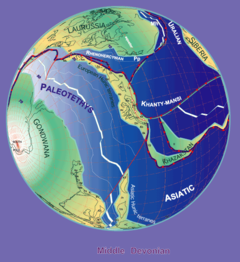| Cuche Formation | |
|---|---|
| Stratigraphic range: Frasnian-Early Carboniferous ~ | |
| Type | Geological formation |
| Unit of | Floresta Massif |
| Underlies | Girón Fm., Tibasosa Fm. |
| Overlies | Floresta Formation |
| Area | ~36 km2 (14 sq mi) |
| Thickness | 300–900 m (980–2,950 ft) |
| Lithology | |
| Primary | Sandstone, siltstone |
| Other | Shale |
| Location | |
| Coordinates | 5°51′37.2″N 72°56′57.6″W / 5.860333°N 72.949333°W |
| Region | Altiplano Cundiboyacense Eastern Ranges, Andes |
| Country | |
| Type section | |
| Named for | Vereda Cuche |
| Named by | Botero |
| Location | Floresta |
| Year defined | 1950 |
| Coordinates | 5°51′37.2″N 72°56′57.6″W / 5.860333°N 72.949333°W |
| Approximate paleocoordinates | 51°42′S 48°06′W / 51.7°S 48.1°W |
| Region | Boyacá |
| Country | |
 Paleogeography of the Middle Devonian 380 Ma, by Stampfli & Borel | |

The Cuche Formation (Spanish: Formación Cuche, Cc) is a geological formation of the Floresta Massif, Altiplano Cundiboyacense in the Eastern Ranges of the Colombian Andes. The sequence of siltstones, shales, and sandstone beds dates to the Late Devonian and Early Carboniferous periods, and has a maximum thickness of 900 metres (3,000 ft).
The formation was deposited in a tidal-dominated deltaic environment at high southern paleolatitudes at the edge of the Paleozoic Paleo-Tethys Ocean. The Cuche Formation is highly fossiliferous; many Placoderm fish fossils, flora, bivalves, arthropods, crustaceans and ostracods have been discovered in the youngest Paleozoic strate of the Floresta Massif, while the underlying Floresta Formation is richer in trilobite biodiversity.[1]